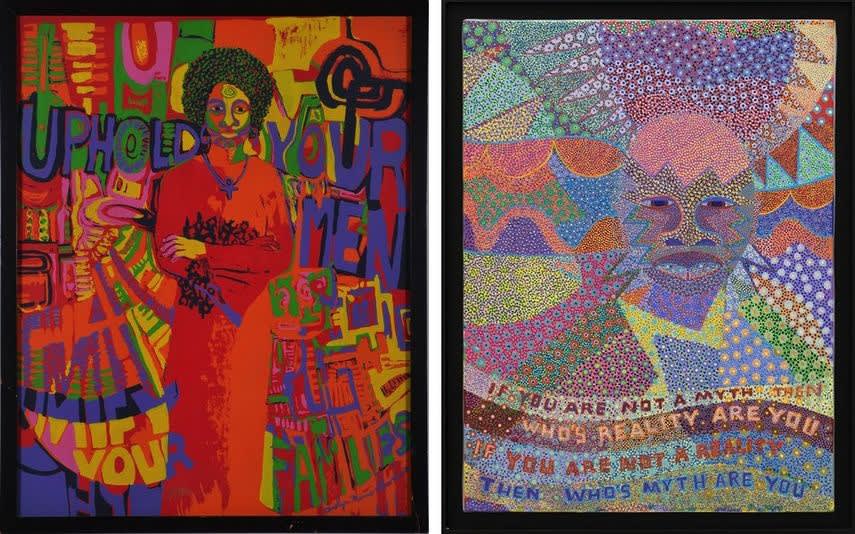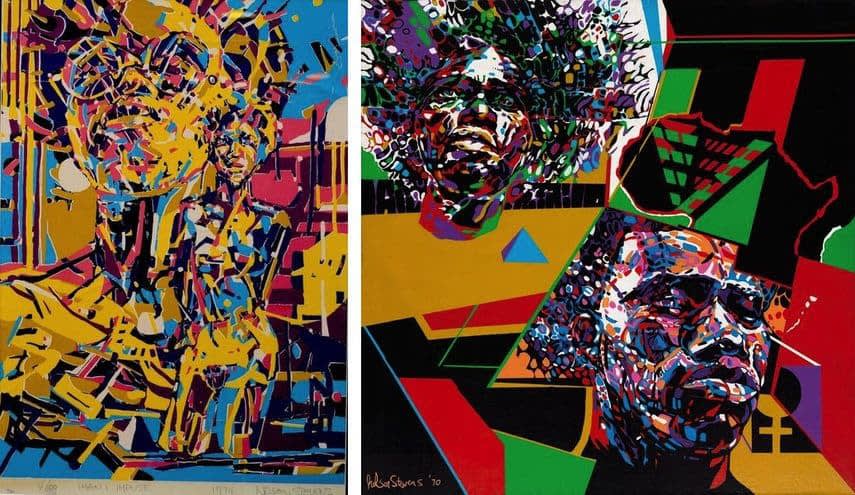
In 1968, a group of African American artists came together at the request of Jeff Donaldson in Jae Jarrell’s studio in Chicago to discuss the premise that black visual arts have innate and intrinsic creative components characteristic of their ethnic group. Composed of a diverse group of black artists which included painters, printmakers, textile designers, dress designers, photographers and sculptors, this group believed that their blackness contributed to a specific quality to their visual expression.
This was the birth of the African Commune of Bad Relevant Artists, or AFRICOBRA, founded by Jeff Donaldson, Jae Jarrell, Wadsworth Jarrell, Barbara Jones-Hogu, and Gerald Williams in Chicago, followed by their manifesto Ten in Search of a Nation. Using their black identity, its style, attitude and worldview, these artists sought to foster solidarity and self-confidence throughout the African diaspora. Their art reflected the revolution of the mind, body and spirit, creating a vision that went on to define a visual aesthetic of the Black Arts Movement.
The upcoming exhibition at The Museum of Contemporary Art North Miami will present a groundbreaking exhibition celebrating the 50th anniversary of the inspiring AFRICOBRA collective. Titled AFRICOBRA: Messages to the People, this historic show will explore the founders’ individual careers and aesthetic and the arts of African American artists who exhibited with them between 1968-1973. It will also examine how the philosophy of the AFRICOBRA movement manifested into their works as a group. The exhibition will feature works by the founders of the 1968 Chicago collective, but also Napoleon Jones-Henderson, Omar Lama, Nelson Stevens, and Gerald Williams.

Left: Carolyn Lawrance, Uphold Your Men, Unify Your Families. Credit to Tony Smith / Right: Gerald Williams, Portrait Y, 1990
The Philosophic, Visual and Social Concepts of AFRICOBRA
AFRICOBRA's founding artists realized that the only possible way to make AFRICOBRA a reality was under a common philosophy and a common system of aesthetic principles. This was all articulated in the 1969 manifesto, Ten in Search of a Nation, which historically reshaped the mindset of black art communities.
Among the first principles was that their arts should be functionalin the way that it must communicate to its viewer a statement of truth, of action, of education of conditions and a state of being to their people - speaking to them and for them. While being aware of the negative experiences of their present and past, they wanted to highlight the positive mode of thought and action. They also focused on the economical mass production techniques such as Poster Art so that everyone that wanted one could have one.
The artworks of the Chicago collective featured black, positive, direct statements created in bright, vivid, singing cool-ade colors of orange, strawberry, cherry, lemon, lime and grape. Combining geometric abstraction and realistic imagery, they developed a style characterized by the use of text, dynamic, gestural markings, and raw, emotive,
celebratory images of confident Black figures. The main core of their work was rhythm, but also the celebration of style, color and life, aimed at expanding the canon to include what they do and who they are.
Their efforts culminated in 1970 with an exhibition Ten in Search of a Nation at the Studio Museum in Harlem. It was the first time that the audience could see a group of artists jointly working together toward a concerted philosophy with images which stated a range of call-to-action messages to Black people.

Left: Nelson Stevens, Imani Impulse, 1972 / Right: Nelson Stevens, Jihad Nation, 1969
A Diverse Group of Artists
Initially consisting of artists Jeff Donaldson, Jae Jarrell, Wadsworth Jarrell, Barbara Jones-Hogu and Gerald Williams, the group soon expanded to include the weaver Napoleon Jones-Henderson, the painter-printmaker Nelson Stevens, the painter Carolyn Lawrence, the draftsman in pen and ink Omar Lama, and the painter and illustrator Sherman Beck. Soon they shifted their perspective from national to international, realizing that all black people everywhere are struggling with the same issues.
Each artist dealt with their images from different perspectives. While Stevens dealt with the spiritual aspect of nation-building in Jihad, Uhuru and Ujamma, Donaldson tackled modern Amos and Andy, characters of the American radio and television sitcom set in Harlem, who are dealing with the communities problems with an advanced weapon. Lawrence used the past and present to create the new image, including tributes to the Pops as an old man, while the dress designer Jae Jarrell incorporated strong patterns, textures and colors of Black Family, Unity and Manhood on her garments.
The artist Wadsworth Jarrell expressed the rhythms of Be-Bop in the repetitious letters and colors, while Beck dealt with the spiritual essence of man. Henderson looked towards himself and Africa as his future, and Williams sought to respond to the potential for Black Nationhood.
Lastly, Jones-Hogu encouraged Black people to unite as a force, and Lama worked toward positive images that would inspire Black people to a higher level of consciousness.

Left: Wadsworth Jarrell, John Coltrane, 1992 / Right: Jae Jarrell, Frock You, 1994.
AFRICOBRA at MOCA North Miami
Even though these artists came together to help each other, many of them were largely ignored by the art world. As people were reluctant to a work by a black artist with a political agenda, these were never offered at auctions or exhibited in big art museums, but only at institutions that focused exclusively on African American artists. Their immense influence was only recently acknowledged.
Indeed, the AFRICOBRA collective directly influenced artists like Kerry James Marshall, who is currently the highest paid living African American artist, and Kehinde Wiley, who recently painted the presidential portrait of Barack Obama.
In 2018, the group AFRICOBRA is still going strong as civil rights activists and an integral part of the black power movement. These are all vibrant, influential artists who are still making arts today.
The exhibition AFRICOBRA: Messages to the People will be on view at The Museum of Contemporary Art North Miami from November 27th, 2018 until April 7th, 2019. It will be curated by Jeffreen M. Hayes, an Executive Director of Threewalls in Chicago, who previously worked at Birmingham Museum of Art, Hampton University Art Museum, the Library of Congress and the National Gallery of Art. The Artist Reception will be on December 4th, from 7 to 10 p.m.





